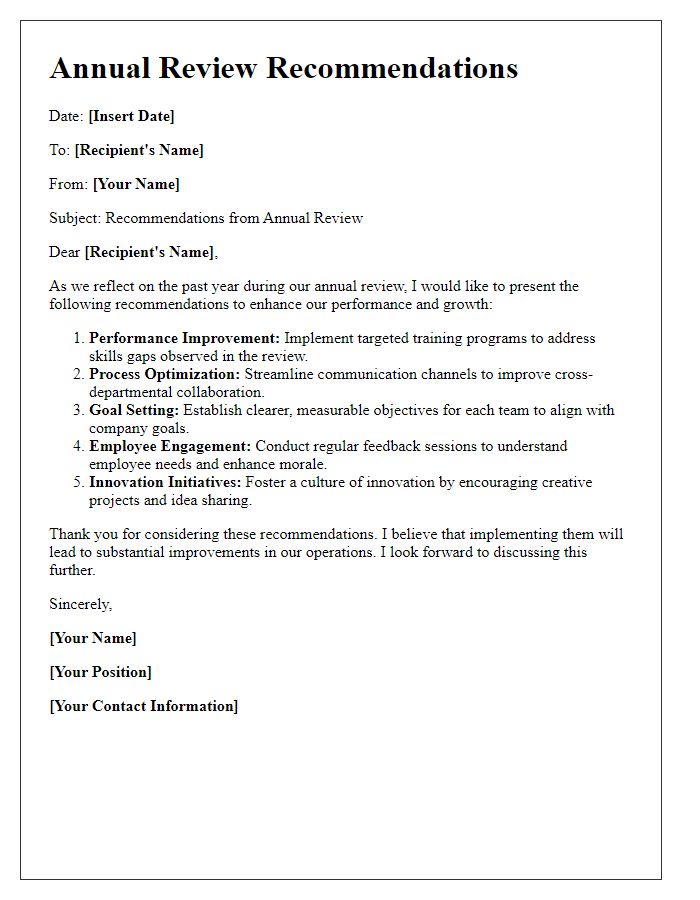Are you ready to navigate the world of annual performance appraisals with confidence? Understanding the structure and intent behind appraisal letters can significantly enhance your professional growth and communication skills. In this article, we'll explore a concise yet effective letter template that ensures clarity, professionalism, and a personal touch in your feedback process. So, grab a cup of coffee and join us as we delve into the essentials of crafting the perfect appraisal letter!

Employee's personal information
During annual performance appraisals, an employee's personal information, including full name and job title, plays a critical role in identifying individual contributions and areas for growth. Date of hire provides context about tenure, while department name and supervisor's details help to clarify reporting structures. Including employee identification number (ID) enhances accuracy in records management, especially in larger organizations. Additionally, performance review period dates (start and end) signify the timeframe for evaluation, ensuring that feedback reflects the complete performance cycle. Documenting contact information, such as email address or phone number, facilitates easy follow-up discussions regarding the appraisal outcomes.
Performance summary
During the annual performance appraisal, the employee demonstrated significant growth and achievement, surpassing objectives set in the beginning of the fiscal year. Key performance indicators (KPIs) indicated a 20% increase in sales for Q2 compared to Q1, showcasing exceptional sales acumen. Successfully led a project team in restructuring the marketing strategy for the new product launch in July, resulting in a 30% rise in customer engagement on social media platforms like Facebook and Instagram. Additionally, collaborative efforts with cross-department teams improved operational efficiency, reducing project delivery time by 15%. Overall, the employee exemplified dedication and adaptability, contributing positively to the company culture and objectives.
Key achievements and contributions
In 2023, significant achievements in project management and team collaboration emerged at XYZ Corporation, a prominent player in the tech industry. Successfully led the "Tech Innovations Initiative," generating a 25% increase in productivity across cross-functional teams, which included over 50 members from departments such as engineering, design, and marketing. Championed the implementation of new Agile methodologies, resulting in a 30% reduction in project turnaround time for critical software releases. Received the "Employee of the Year" award for exemplary leadership during the "Product Launch Extravaganza" event in March, which attracted over 1,000 participants and resulted in a 40% increase in customer engagement. Mentored five junior associates, fostering skill development and enhancing team dynamics, which contributed to a noticeable rise in morale and collaborative spirit within the department.
Areas for improvement
Annual performance appraisal highlights the necessity for improvement in key areas within an organization. Commonly, employees may need to enhance communication skills, especially in collaborative environments. Time management techniques can also be beneficial, enabling efficient task prioritization and project completion. Furthermore, the understanding of industry-specific knowledge, such as emerging trends and technologies, plays a crucial role in professional growth. Additionally, participation in training programs or workshops can facilitate skill enhancement, promoting overall effectiveness in one's role. Emphasizing a proactive approach toward setting measurable goals will foster continuous development and align with organizational objectives.
Goals and objectives for the upcoming period
Setting clear goals and objectives is crucial for the upcoming evaluation period. Specific objectives, such as increasing sales by 20% in the fourth quarter, can directly impact overall company revenue. Personal development goals might include attending at least three professional workshops focused on leadership skills, critical for career advancement. Collaborative objectives should aim for improved teamwork within project teams, emphasizing the importance of communication tools like Slack and Zoom, to ensure seamless information sharing. Additionally, exploring innovative strategies to enhance customer satisfaction by achieving a 90% positive feedback rating can foster loyalty and retention. These defined milestones will guide performance and progress throughout the year.













Comments